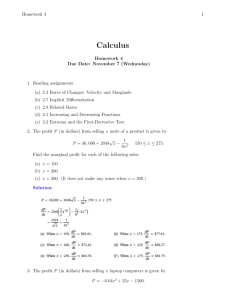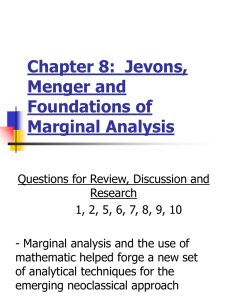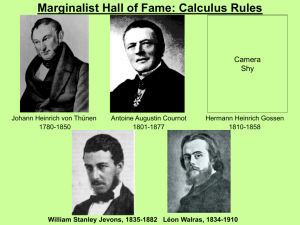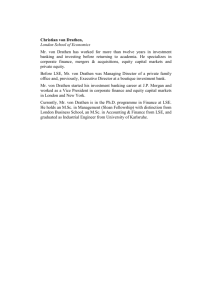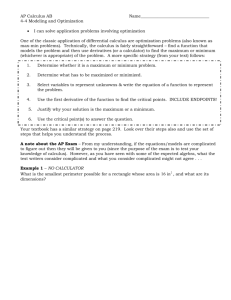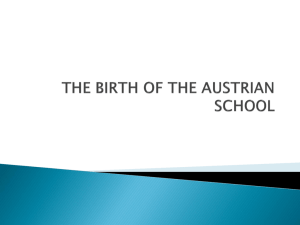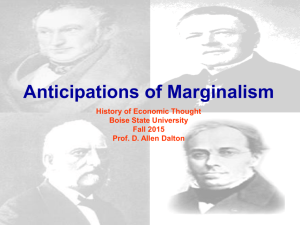Marginalist Revolution (Prior to Marshall)
advertisement
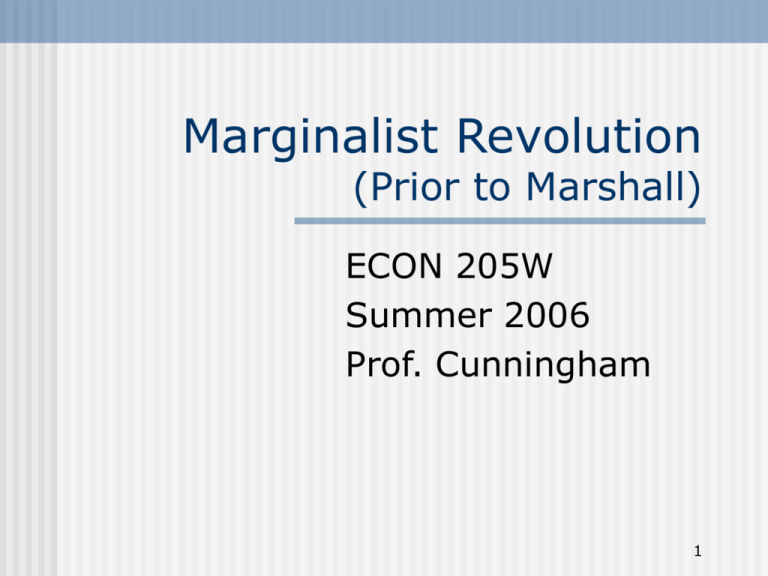
Marginalist Revolution (Prior to Marshall) ECON 205W Summer 2006 Prof. Cunningham 1 Identifying Elements Applications of calculus, physics, engineering to economic analysis. Labor theory of value is disproved. Marginal principle provides a unifying framework. Less emphasis on growth. Focus on optimization. Equilibrium method. Mathematical methods and focus on economic science. 2 Related Issues Was it a revolution? What took so long? Change in method. Resistance by orthodoxy. Three stages in the development of the marginalist principle. 3 The Method of the Marginalists Marginal principle. Microeconomic emphasis. Abstract, deductive method. Assumption of perfect competition. Less emphasis on supply, more on demand in price setting. Subjective valuation. Equilibrium approach. Equal footing for all factors of production. Rational agents. Minimal government involvement. 4 Additional Considerations Who benefits? Implications? Longevity of the theory? 5 Forerunners of neoclassicals 1814, Malthus mentions that differential calculus might be useful in economics. 1824, Perronet Thompson became the first writer in English economist to use the calculus in economic analysis. 1815, Georg von Buquoy applied the calculus to an agricultural problem. 1839, Charles Ellet used the calculus to determine an optimal tariff. 6 Augustin Cournot (1801-77) Background 1838, Researches into the Mathematical Principles of the Theory of Wealth First systematic development of the application of the marginal principle to the firm Math. Econ of the “pure” type Approach was consistent with French Rationalism: a theory that reason is in itself a source of knowledge superior to and independent of sense perceptions 7 Cournot (2) Supply and Demand Hypothesis: each person seeks the greatest value from his/her property or labor. Theory of monopoly, builds on this until he reaches the competitive case. Theory of the firm 8 Johann Heinrich von Thünen (1783-1850) Background The Isolated State Sought empirical verification for certain principles he had deduced from observation. Natural wage = a p Isolated State = ideal closed economy Developed principles of variable proportion and substitution Widely acclaimed during his life. 9 Hermann Heinrich Gossen (1810-58) Theory of Consumption Frustrated by the neglect of others to his work. 1854, Development of the Laws of Human Relationships and of the Rules to be Derived Therefrom for Human Action. Gossen’s Two Laws. Contributions largely unrecognized until 1878 when Jevons pointed out his work to Walras. 10 The “Revolution” Almost simultaneous publication in the 1870s of books by: William Stanley Jevons (1871), The Theory of Political Economy (England) Carl Menger (1871), Principles of Economics (Vienna, Austria) Leon Walras (1874-77), Elements of Pure Economics (Switzerland) 11 Revolution (2) Contributions of the three Why were the able to promote the new theory now? What was their influence? 12 William Stanley Jevons (1835-82) Background 1971, Principles of Political Economy Not aware of the work of Cournot, Thunen, or Gossen Extensive use of utility theory On the labor theory of value Empirics 1865, The Coal Question 1884, Investigations in Currency and Finance Includes a discussion of business cycles 13 Francis Ysidro Edgeworth (1845-1926) Editor of the Economic Journal Wrote many articles and a monograph entitled Mathematical Psychics (1881) Sought to apply mathematics to the social sciences Expanded Jevons notions on the utility function Introduced indifference curves and the Edgeworth box 14 Philip H. Wicksteed (1844-1927) Developed a theory of marginal productivity and distribution. He alone asked whether and under what conditions the total product would be exhausted by the marginal products Answer: Euler’s Theorem TP xi MPxi i 15 Wicksteed (2) Argued that exhaustion of the marginal product requires a linear homogeneous production function. Also argued that this requires constant returns to scale. 1894, Essay on the coordination of the Laws of Distribution Not a fan of Marshall’s supply-demand apparatus. 16 Carl Menger (1840-1921) Background Had a substantial following, and came to be considered the leader of the Austrian School. Opposed by the German Historical School. Substantial legal training led him to make careful definitions. Unlike Jevons and others, related utility maximization to “needs” not “pleasure”. 17 Menger (2) Theory of Imputation (Zurechnung) Value is not inherent in goods, but is imputed to them. Value = exchange value. Monetary Theory 1883, Problems of Economics and Sociology Defense of Menger’s approach to economics 18 Friedrich von Wieser (1851-1926) Eugen von Bohm-Bawerk (1851-1914) Later Austrians—von Hayek, von Mises, Schumpeter—were students of these two. Bohm-Bawerk always aware of the “cutting edge” of thinking, while von Wieser was completely attached from his time. Both argued strongly against socialism. 19


